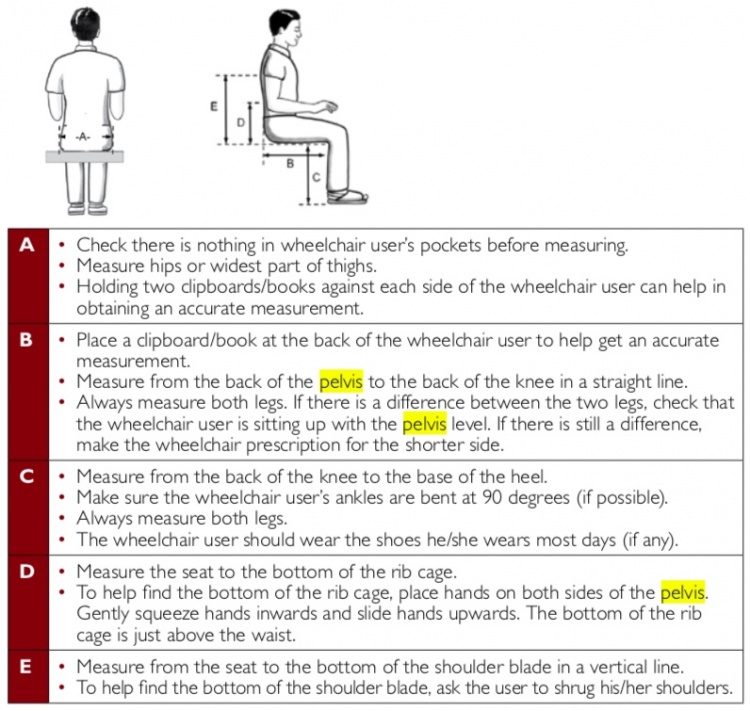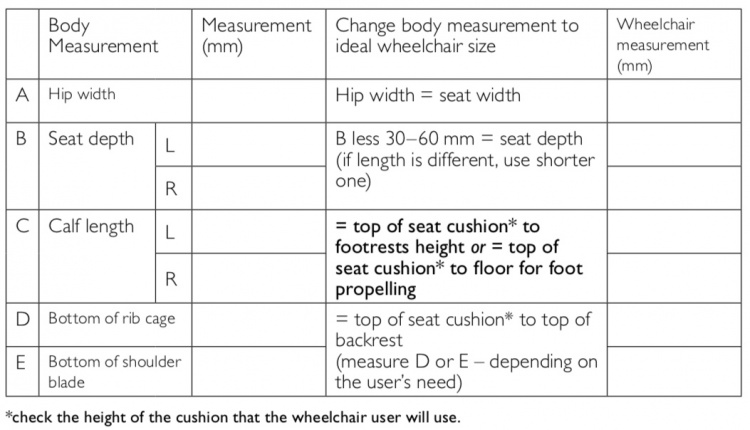Wheelchair Assessment - Body Measurements: Difference between revisions
(Created page with "<div class="editorbox"> '''Original Editor '''- Your name will be added here if you created the original content for this page. '''Top Contributors''' - {{Special:Contributo...") |
No edit summary |
||
| Line 5: | Line 5: | ||
</div> <div align="justify"> | </div> <div align="justify"> | ||
== Introduction == | == Introduction == | ||
Accurate measurement of the client will enable clinicians to: | |||
* Correctly size trial equipment for the client | |||
* Reduce the number of client transfers and improve time management by pre-setting the seating and wheeled mobility equipment according to body measurement prior to an appointment | |||
* Have an accurate reference for the final seating configuration and any future equipment trials, and | |||
* Outline the clinical reasoning behind the specifications of wheeled mobility prescriptions in funding applications.<div align="justify"><div align="justify"> | |||
* | == Preparations == | ||
* | |||
== | |||
=== Measuring Tools === | |||
<div align="justify"><div align="justify"><div align="justify"> | |||
* Use a retractable metal tape measure | |||
== | |||
== | |||
<div align="justify"> | |||
* Use a retractable metal tape measure | |||
* clipboards/books can be used to help measure accurately (see How to take body measurements). | * clipboards/books can be used to help measure accurately (see How to take body measurements). | ||
* Large callipers are an additional tool that can be very useful. These can be made locally from wood. | * Large callipers are an additional tool that can be very useful. These can be made locally from wood. | ||
* Foot-blocks can be used to support the wheelchair user’s feet at the correct height. | * Foot-blocks can be used to support the wheelchair user’s feet at the correct height. | ||
==== | === Process === | ||
<div align="justify"><div align="justify"><div align="justify"><div align="justify"><div align="justify"> | |||
<div align="justify"> | |||
* Ask the wheelchair user to sit as upright as possible. | * Ask the wheelchair user to sit as upright as possible. | ||
* The wheelchair user’s feet should be supported on the floor or on foot-blocks if they cannot reach the floor comfortably. | * The wheelchair user’s feet should be supported on the floor or on foot-blocks if they cannot reach the floor comfortably. | ||
| Line 56: | Line 28: | ||
[[File:Measuring.jpeg|frameless|750x750px]] | [[File:Measuring.jpeg|frameless|750x750px]] | ||
== Specific Measurements == | |||
A well-fitted seating and wheeled mobility system requires a ‘made-to-measure’ solution. Generally, the more seating surface that is in contact with the client, the more body measurements need to be obtained for a wheelchair prescription. | |||
=== Basic Measurements === | |||
Five measurements from the wheelchair user are needed to choose the best available size of wheelchair for for a wheelchair user that does not require additional postural support and has good trunk control. | |||
=== Intermediate Measurements === | |||
<div align="justify"><div align="justify"><div align="justify"><div align="justify"><div align="justify"> | |||
<div align="justify"><div align="justify"><div align="justify"> | |||
<div align="justify"> | |||
[[File:Taking Measurements.jpeg|frameless|750x750px]] | |||
== Resources == | == Resources == | ||
Revision as of 00:36, 18 July 2018
Original Editor - Your name will be added here if you created the original content for this page.
Top Contributors - Naomi O'Reilly, Rucha Gadgil, Amrita Patro, Olajumoke Ogunleye and Kim Jackson
Introduction[edit | edit source]
Accurate measurement of the client will enable clinicians to:
- Correctly size trial equipment for the client
- Reduce the number of client transfers and improve time management by pre-setting the seating and wheeled mobility equipment according to body measurement prior to an appointment
- Have an accurate reference for the final seating configuration and any future equipment trials, and
- Outline the clinical reasoning behind the specifications of wheeled mobility prescriptions in funding applications.
Preparations[edit | edit source]
Measuring Tools[edit | edit source]
- Use a retractable metal tape measure
- clipboards/books can be used to help measure accurately (see How to take body measurements).
- Large callipers are an additional tool that can be very useful. These can be made locally from wood.
- Foot-blocks can be used to support the wheelchair user’s feet at the correct height.
Process[edit | edit source]
- Ask the wheelchair user to sit as upright as possible.
- The wheelchair user’s feet should be supported on the floor or on foot-blocks if they cannot reach the floor comfortably.
- For all measurements, make sure the tape measure is held straight and the wheelchair user is sitting upright. Holding a clipboard/book on either side of the wheelchair user can help in obtaining an accurate measurement.
- Bend down to ensure you are viewing the tape measure at the correct angle.
Specific Measurements[edit | edit source]
A well-fitted seating and wheeled mobility system requires a ‘made-to-measure’ solution. Generally, the more seating surface that is in contact with the client, the more body measurements need to be obtained for a wheelchair prescription.
Basic Measurements[edit | edit source]
Five measurements from the wheelchair user are needed to choose the best available size of wheelchair for for a wheelchair user that does not require additional postural support and has good trunk control.








